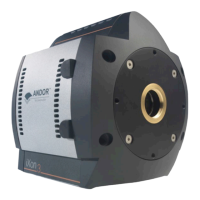Page 60
Features & Functionality
To successfully photon count with EMCCDs, there has to be a signicantly higher probability of seeing a ‘photon spike’
thanseeingadarkcurrent/CIC‘noisespike’.Thelowerthecontributionofthis‘spurious’noisesourcetoasingle
exposure within the accumulated series, the lower the detection limit of photon counting and the cleaner the overall
image will be, as demonstrated in Figure 43 below:
Figure 42: ‘Photon Counting’ vs. ‘Standard EM-on’ Imaging for very weak signals. Images A, B and C were recorded under identical illumination
conditions, identical exposure times and each with EM Gain set at x1000. The benet of photon counting under conditions of low clock induced
charge (CIC) is evident. Images D and E are derived from a larger number of accumulated images, to yield a greater measurable signal to noise
ratio. An identically positioned Region of Interest on each image was used to determine S/N of 3.86 and 6.02 for standard and photon counted
images respectively. This factor improvement is in accord with the theory of Photon Counting circumventing the inuence of multiplicative noise
(noise factor) in EMCCD signals.

